IATA estimates that around 35% of world trade is transported through air freight, which accounts to approximately $6 trillion. Just within a single day, about 140,000 tonnes (30,8647,167 lbs) and 20 million parcels of air cargo are flown around the world.
This is only possible through large fleets of cargo planes that soar through our skies on a daily basis. These engineering marvels are designed to transport all types of goods from one location to another.
While many of these freighters haul heavy commercial cargo, some of these aircrafts are even used for military purposes. But which of these freighters is the biggest? Well, let’s take a look at the 15 largest cargo planes in the world today!
1. Antonov An-225 Mriya
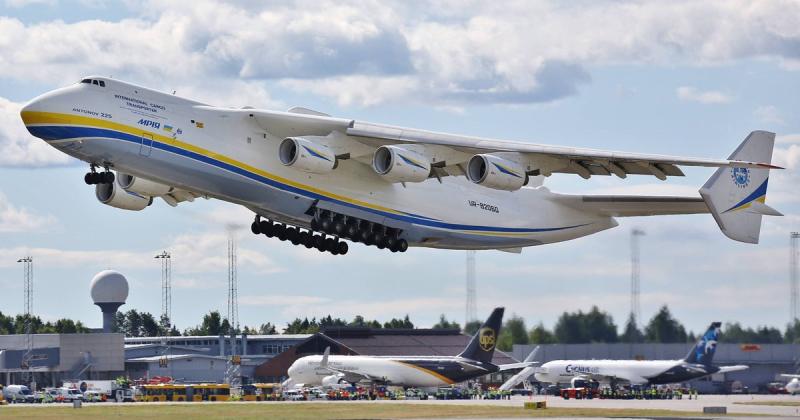
- Maximum Takeoff Weight: 640,000 kg (1,410,958 lbs)
- Payload: 250,000 kg (551,156 lbs)
- Cargo Hold: 1,300 m3 (46,000 cu ft)
- Overall Length: 84 m (275 ft 7 in)
- Wingspan: 88.4 m (290 ft)
- Range: 15,400 km (8,315 nmi)
- Cruise Speed: Mach 0.65 (800 km/h, 430 kn)
- Aircraft Type: Commercial Freighter
The Antonov An-225 Mriya is the largest cargo plane in the world and was developed in 1985 in the Soviet Union. There was only one of these planes ever built and it’s still in operation today. Its wingspan is the largest of any operational aircraft and it’s also the heaviest plane ever made.
The Antonov An-225 has an impressive maximum takeoff weight of 640,000 kg (1,410,958 lbs) and is powered by six Progress D-18T turbofans. Its cargo hold is 1,300 cubic meters (46,000 cu ft) and can carry payloads of up to 250,000 kg (551,156 lbs).
The Antonov An-225’s landing gear has a total of 32 wheels, in order to support its massive weight. It also happens to be the longest operational aircraft at 84 m (275′-7″). With a range of 15,400 km the Antonov An-225 is regularly chartered for oversized and project cargo.
2. Boeing 747-8F
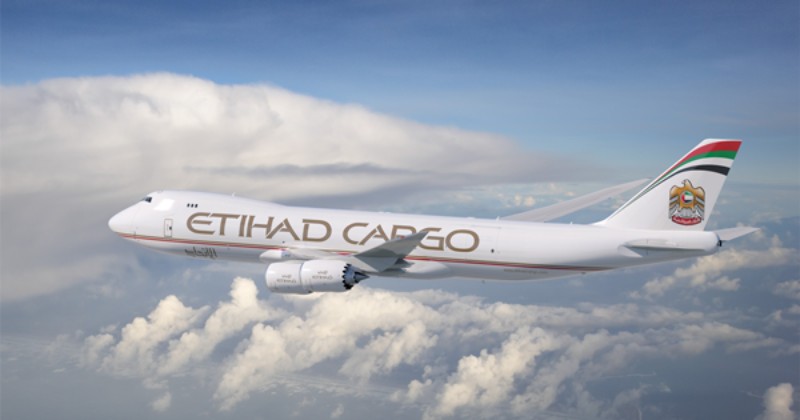
- Maximum Takeoff Weight: 447,700 kg (987,000 lbs)
- Payload: 132,600 kg (292,400 lbs)
- Cargo Hold: 858 m3 (30,288 cu ft)
- Overall Length: 76.3 m (250 ft 2 in)
- Wingspan: 68.4 m (224 ft 7 in)
- Range: 7,630 km (4,120 nmi)
- Cruise Speed: Mach 0.74 (914 km/h, 494 kn)
- Aircraft Type: Commercial Freighter
The Boeing 747-8F originates from the United States and had its first flight in 2010. It is part of the 747-8 family, and Boeing has produced a total of 141 of such planes. This cargo plane is powered by the General Electric GEnx turbofans and is one of the most popular commercial freighters around, as it facilitates nose loading to support voluminous cargo.
With a maximum takeoff weight of 447,700 kg (987,000 lbs), the Boeing 747-8F is one of the largest cargo planes in existence today. It has a cargo hold of 858 cubic meters or 30,288 cubic feet. It can hold a maximum payload of 132,600 kg (292,400 lbs) with a crew of 2 people.
The length of this behemoth is 76.3 meters (250’-2”) and its wingspan is 68.4 meters (224’-7”). The Boeing 747-8F is used by many commercial airlines as a cargo plane for scheduled flights and also charters.
3. Lockheed C-5 Galaxy
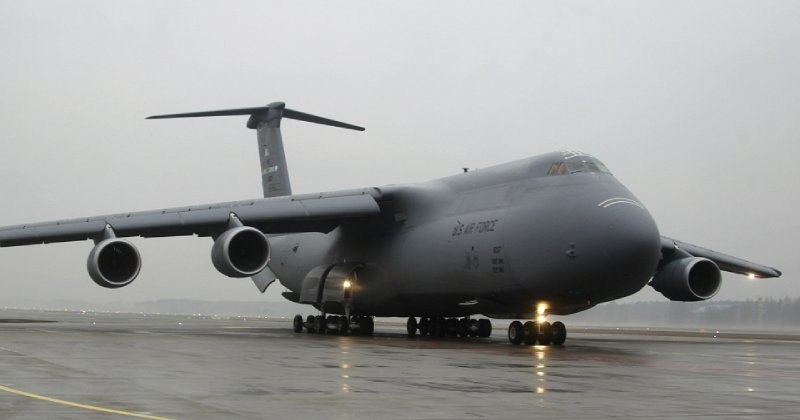
- Maximum Takeoff Weight: 417,305 kg (920,000 lbs)
- Payload: 127,459 kg (281,000 lbs)
- Cargo Hold: 880 m3 (31,000 cu ft)
- Overall Length: 75.31 m (247 ft 1 in)
- Wingspan: 67.89 m (222 ft 9 in)
- Range: 11,705 km (6,320 nmi)
- Cruise Speed: Mach 0.7 (869 km/h, 469 kn)
- Aircraft Type: Military Transporter/Freighter
The Lockheed C-5 Galaxy belongs to the United States Air Force and was manufactured in 1968. There were a total of 131 of these aircrafts built. This model has been helpful in various major conflicts such as Vietnam, Iraq, and Afghanistan and is still in operation today.
The Lockheed C-5 Galaxy boasts an MTOW of 417,305 kg or 920,000 lbs. Its cargo hold has a volume of 880 cubic meters or 31,000 cubic feet. It can hold a payload with a maximum weight of 127,459 kg or 281,000 lbs and supports a crew of up to 7.
It is a little shorter in length than the Boeing 747-8F, at 75.31 m (247’-1”) and is powered by four powerful General Electric TF39. The Lockheed C-5 Galaxy has a long range of 11,705 km (6,320 nmi), which makes it an ideal cargo plane that is used for military operations.
4. Boeing 747-400ERF
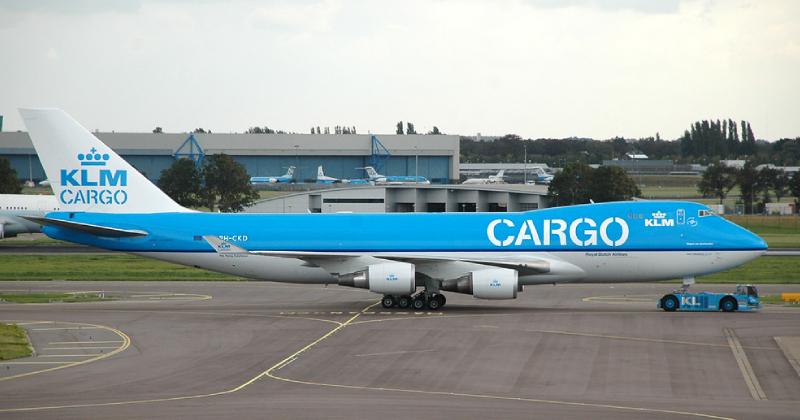
- Maximum Takeoff Weight: 412,769 kg (910,000 lbs)
- Payload: 124,012 kg (273,400 lbs)
- Cargo Hold: 779 m3 (27,467 cu ft)
- Overall Length: 70.66 m (231 ft 10 in)
- Wingspan: 64.44 m (211 ft 5 in)
- Range: 9,230 km (4,985 nmi)
- Cruise Speed: Mach 0.85 (498 kn; 922 km/h)
- Aircraft Type: Commercial Freighter
The Boeing 747-400ERF belongs to the 747-400 family and is another large freighter by Boeing. ERF stands for ‘Extended Range Freighter’ and the 747-400ERF came into operation in 2002; the first one was delivered to Air France.
The Boeing 747-400ERF has a maximum takeoff weight of 412,769 kg (910,000 lbs) and its cargo hold has a volume of 779 m3 (27,467 cu ft). This makes it one of the largest cargo planes in the world. It can hold a total payload of 124,012 kg (273,400 lbs) and has space for up to 2 crew members.
It has a length of 70.66 m (231’-10”) and a wingspan of 64.44 m (211’-5”). The 747-400ERF has a cruising speed of Mach 0.845 which is equivalent to 922 km/h or 498 kn. It has a range of 9,230 km (4,895 nmi) and is powered by either four PW4000 or GE CF6 engines. Today, this aircraft is commonly used as a commercial cargo plane by various airlines such as KLM and Air France.
5. Antonov An-124 Ruslan
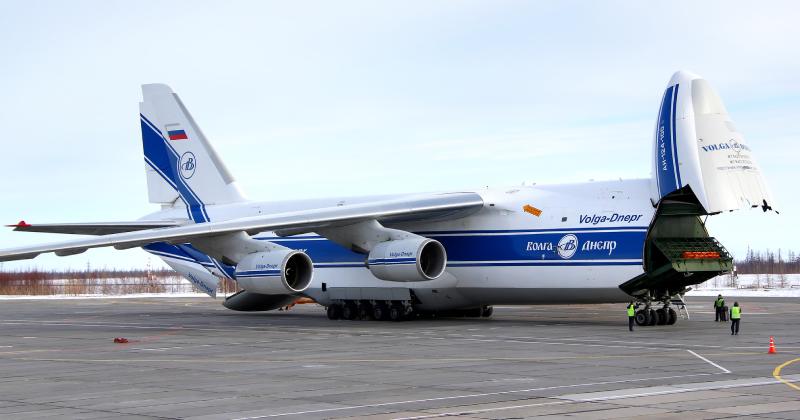
- Maximum Takeoff Weight: 402,000 kg (886,258 lbs)
- Payload: 150,000 kg (330,693 lbs)
- Cargo Hold: 1,091 m3 (38,528 cu ft)
- Overall Length: 69.1 m (226 ft 8 in)
- Wingspan: 73.3 m (240 ft 6 in)
- Range: 1,500 km (6,200 nmi)
- Cruise Speed: Mach 0.7 (865 km/h, 467 kn)
- Aircraft Type: Commercial Freighter
The Antonov An-124 Ruslan was first introduced in 1986 and originates from the Soviet Union. There were a total of 55 models built between 1982 – 2004. Today, this aircraft is used as a commercial freighter and as of 2019, there are 26 of them in service.
The Antonov An-124 makes this list due to its MTOW of 402,000 kg (886,258 lbs). It has a very large cargo hold with a volume of 1,091 m3 or 38,528 cubic feet. It can support a payload with a maximum weight of 150,000 kg (330,693 lbs). The maximum number of crew on board is 6.
The cargo plane has a length of 69.1 m (226’-8”), a wingspan of 73.3m (240’-6”) and a cruise speed of 865 km/h. Before the Boeing 747-8F and Antonov An-225 Mriya, the An-124 was known to be the largest cargo aircraft in the world.
6. Boeing 747-200F
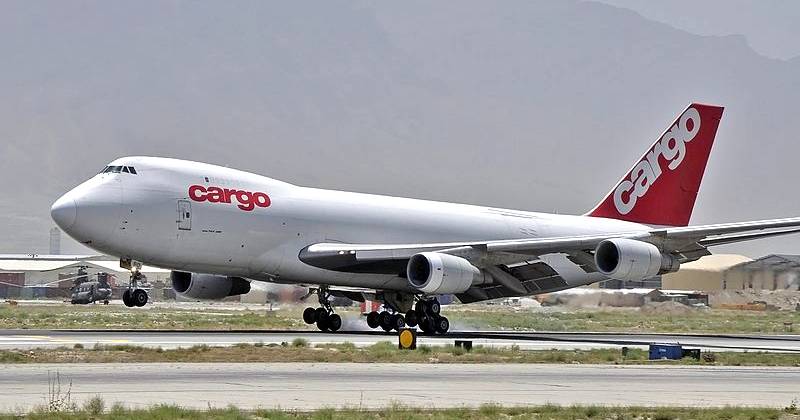
- Maximum Takeoff Weight: 396,900 kg (875,000 lbs)
- Payload: 100,000 kg (220,463 lbs)
- Cargo Hold: 605 m3 (21,365 (cu ft)
- Overall Length: 70.70 m (232 ft)
- Wingspan: 64,40 m (211 ft)
- Range: 11,380 km (6,145 nmi)
- Cruise Speed: Mach 0.73 (895 km/h, 483 kn)
- Aircraft Type: Commercial Freighter
The Boeing 747-200F saw its first flight all the way back in 1972 with Lufthansa and was famous for its hinged nose cargo door. As typical with Boeing planes, the “F” stands for ‘Freighter’ and is the cargo version of the popular 747-200 line.
Even though development started many years ago, they are still in operation today, albeit very few. However, this is a testament to its success over the years – and still is.
The Boeing 747-200F has a maximum takeoff weight of 396,900 kg (875,000 lbs) and a cargo hold with a volume of 605 cubic meters (21,365 cubic feet). It can hold payloads of up to 100,000 kg (220,463 lbs) and has space for a maximum of 2 crew members on board.
7. Boeing 747-400F
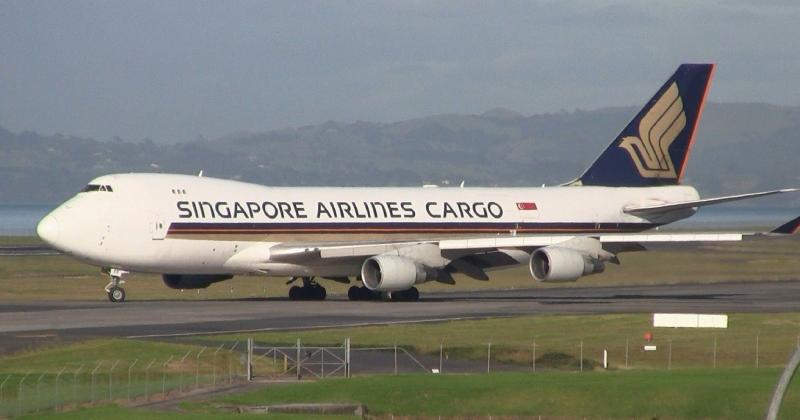
- Maximum Takeoff Weight: 396,893 kg (875,000 lbs)
- Payload: 124,330 kg (274,100 lbs)
- Cargo Hold: 714 m3 (25,200 cu ft)
- Overall Length: 70.66 m (231 ft 10 in)
- Wingspan: 64.44 m (211 ft 5 in)
- Range: 8,250 km (4,455 nmi)
- Cruise Speed: Mach 0.845 (922 km/h, 498 kn)
- Aircraft Type: Commercial Freighter
The 747-400F is the all-freight version of the 747-400 class and is another well-known aircraft for many carriers. The 747-400F was produced between 1993 to 2009 with a price of $268 million, and a total of 126 were delivered to various airlines.
The 747-400F has an MTOW of 396,893 kg (875,000 lbs), similar to the 747-200F. It has a larger cargo hold, with a volume of 714 m3 (25,200 cubic ft.) It can hold a maximum payload of 124,300 kg (274,100 lbs) and is suitable for 2 crew members.
With a cruise speed of 922 km/h (498 kn) and a range of 8,250 km (4,455 nmi) the 747-400F is able to do medium and long haul cargo runs. They have been successful cargo freighters over the years, which are still in service today.
8. Boeing 747-300SF
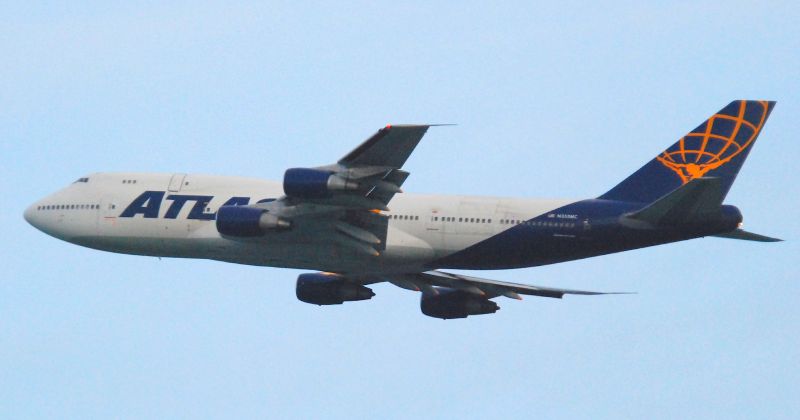
- Maximum Takeoff Weight: 377,800 kg (832,906 lbs)
- Payload: 106,000 kg (233,689 lbs)
- Cargo Hold: 704.6 m3 (24,885 cu ft)
- Overall Length: 70.66 m (232 ft)
- Wingspan: 59.64 m (195 ft 3 in)
- Range: 11,723 km (6,330 nmi)
- Cruise Speed: Mach 0.72 (893 km/h, 482 kn)
- Aircraft Type: Commercial Freighter
The Boeing 747-300SF is a unique aircraft, as the “SF” stands for special freighter. SFs are now called Boeing Converted Freighters “BCF” and are 747-300 that were converted to carry freight, instead of passengers. The 300SF was popular in the 1980s and was also known for its low operating cost.
It has a maximum takeoff weight of 377,800 kb (832,906 lbs). Its cargo hold has a volume of 704.6 m3 (24,885 cu ft). It has the capacity to hold a payload of 106,000 kg or 233,689 lbs and up to 2 crew members, a pilot and co-pilot.
The Boeing 747-300SF has a cruise speed of Mach 0.74, which is about 893 km/h (482 kn). With a range of 11,723 km (6,330 nmi) it is still utilized today for commercial purposes.
9. Boeing Dreamlifter
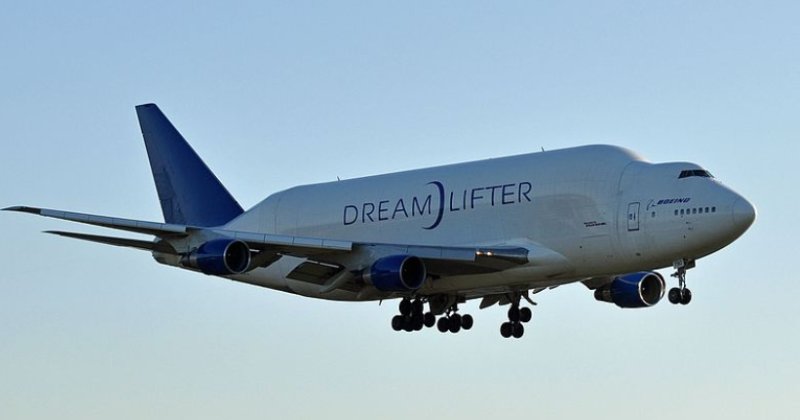
- Maximum Takeoff Weight: 364,235 kg (803,001 lbs)
- Payload: 113,400 kg (250,000 lbs)
- Cargo Hold: 1,840 m3 (65,000 cu ft)
- Overall Length: 71.68 m (235 ft 2 in)
- Wingspan: 64.4 m (211 ft 5 in)
- Range: 7,800 km (4,212 nmi)
- Cruise Speed: Mach 0.82 (474 kn, 878 km/h)
- Aircraft Type: Dedicated Boeing Freighter
The Boeing Dreamlifter was introduced in 2007 and is a modified version of the queen of the skies, the 747-400. There are 4 of these planes built and are still in service transporting Boeing parts, such as fuselages, between production sites.
The Dreamlifter is the second most voluminous cargo plane on this list, after the Airbus Beluga XL, in terms of its cargo hold volume. It has the ability to hold cargo with a volume of 1,840 m3 (65,000 cubic feet) and a payload of 113,400 kg (250,000 lbs).
Its primary use is the transfer of aircraft components for the Boeing 787 Dreamliner to the company’s various assembly plants. Transporting Boeing fuselages in the Dreamliner is extremely convenient, as it is equipped with a swing tail door and it can also raise its nose.
10. Boeing 777F
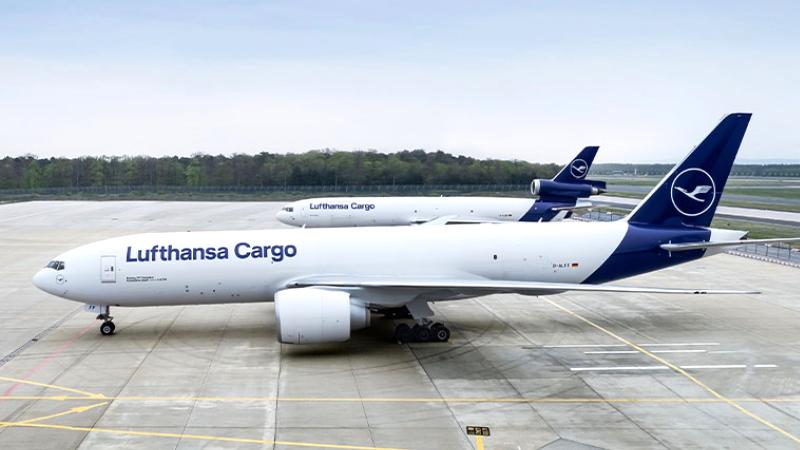
- Maximum Takeoff Weight: 347,452 kg (766,000 lbs)
- Payload: 103,000 kg (227,076 lbs)
- Cargo Hold: 653 m3 (23,051 cu ft)
- Overall Length: 63.73 m (209 ft 1 in)
- Wingspan: 64.80 m (212 ft 7 in)
- Range: 9,038 km (4,880 nmi)
- Cruise Speed: Mach 0.84 (905 km/h, 490 kn)
- Aircraft Type: Commercial
This 777F is the freighter version of the 777-200LR and shares many of its traits, for example fuselage, overall length and wingspan. While the first 777F was delivered back in 2009, it remains an extremely popular commercial cargo freighter today with airlines such as Air France, Lufthansa, KLM and many more.
As of 2021, 247 Boeing 777F have been produced with a listing price of US$352.3 million. What makes Boeing’s largest twin-engine freighter so popular is its MTOW of 347,452 kg (766,000 lbs) and a cargo hold volume of 653 m3 (23,051 cubic ft.). It can carry payloads of up to 103,000 kg (227,076 lbs).
Similar to the 777-200LR, this cargo plane is 63.73 m (209’-1”) long, with a wingspan of 64.80 m (212’-7”). As it’s based on the long range version of the 777, it has a maximum range at full capacity of 9,038 km (4,880 nmi), making it a great medium and long haul freighter.
11. Boeing C-17 Globemaster III
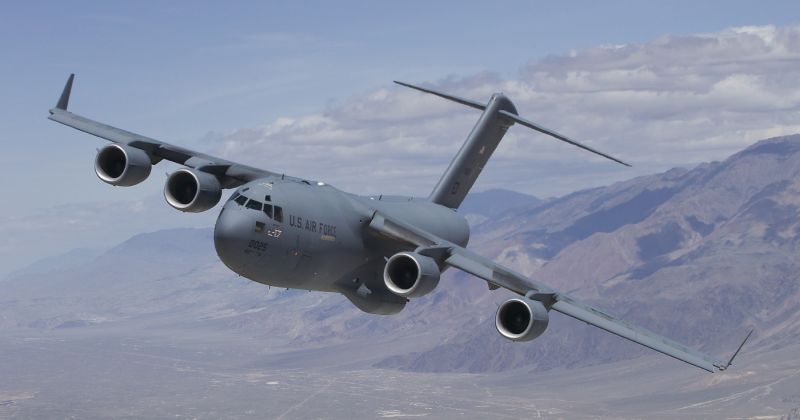
- Maximum Takeoff Weight: 265,352 kg (585,000 lbs)
- Payload: 77,519 kg (170,900 lbs)
- Cargo Hold: 583 m3 (20,592 cu ft)
- Overall Length: 53.04 m (174 feet)
- Wingspan: 51.75 m (169 ft 10 in)
- Range: 4,444 km (2,400 nmi)
- Cruise Speed: Mach 0.74 (914 km/h, 493 kn)
- Aircraft Type: Military Transporter/Freighter
It’s pretty evident by now that Boeing is dominating the freighter list, but also for military aircraft. The Boeing C-17 Globemaster III was developed jointly with McDonnell Douglas for military cargo and troop transportation for The United States Air Force.
The C-17 Globemaster III has a maximum takeoff weight of 265,352 kg (585,000 lbs). Its cargo hold has a volume of 583 cubic meters (20,592 cubic feet) with a maximum payload capacity of 77,519 kg (170,900 lbs). This makes it an extremely effective military airlifter.
The C-17 Globemaster III had its maiden flight in 1991. Still today, it’s known to be one of the US Air Force’s most strategic military transport aircraft with a total of 279 being produced over the last few decades.
12. Antonov An-22
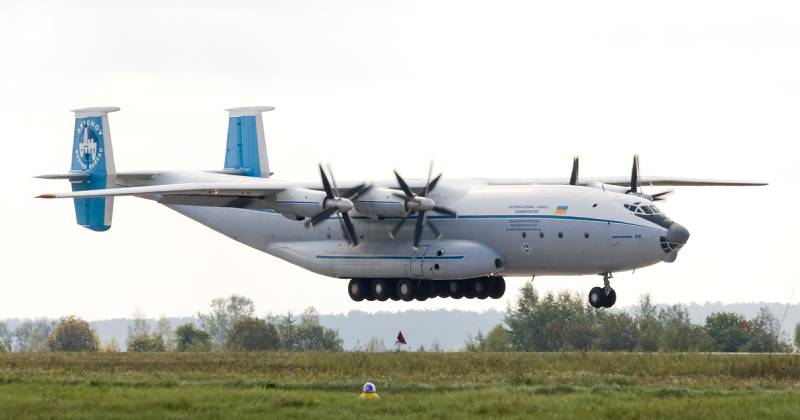
- Maximum Takeoff Weight: 250,000 kg (551,156 lbs)
- Payload: 80,000 kg (176,370 lbs)
- Cargo Hold: 1,300 m3 (46,000 cu ft)
- Overall Length: 57.92 m (190 ft 0 in)
- Wingspan: 64.4 m (211 ft 3 in)
- Range: 10,950 km (6,800 mi; 5,910 nmi)
- Cruise Speed: Mach 0.45 (560 km/h, 302 kn)
- Aircraft Type: Military Transporter/Commercial Freighter
The Antonov An-22 also goes by the name of “Antei” and originates from the Soviet Union. It was in production between 1966 – 1976 and a total of 69 of these freighters have been built. Powered by four Kuznetsov NK-12MA turboprop engines, each with a capacity of 11,000 kW, they are still in operation today.
The An-22 by Antonov has a maximum takeoff weight of 250,000 kg (551,156 lbs). It has a large cargo hold with a volume of 1,300 cubic meters or 46,000 cubic feet. It can hold a payload of up to 80,000 kg (176,370 lbs), which was a significant feat during that era.
The range of the Antonov An-22 is impressive too, at 10,950 km, which is 6,800 miles or 5,910 nautical miles. This strategic airlifter is still in use by the Russian Air Force for military purposes, and in Ukraine for moving commercial freight. Today, the An-22 remains the largest turboprop-powered plane in the world.
13. Airbus Beluga XL
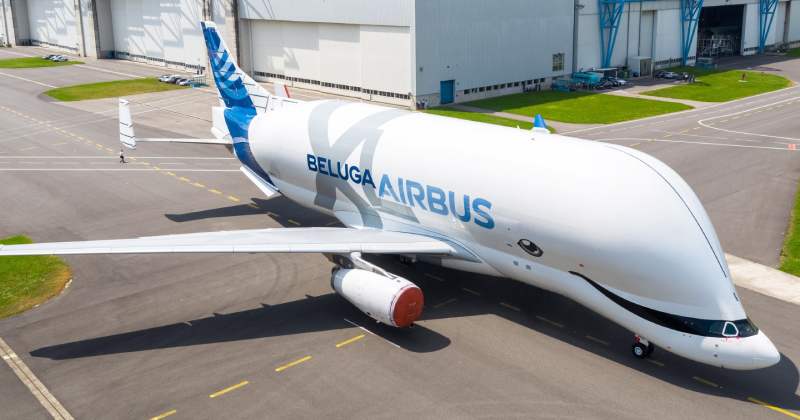
- Maximum Takeoff Weight: 227,000 kg (500,449 lbs)
- Payload: 50,500 kg (111,333 lbs)
- Cargo Hold: 2,209 m3 (78,000 cu ft)
- Overall Length: 63.1 m (207 ft 0 in)
- Wingspan: 60.3 m (197 ft 10 in)
- Range: 4,300 km (2,600 mi, 2,300 nmi)
- Cruise Speed: Mach 0.69 (737 km/h, 398 kn)
- Aircraft Type: Dedicated Airbus Freighter
The Airbus Beluga XL gets its name not only from its large size but also because it’s resemblance to a beluga whale. Airbus started the development of this freighter in 2016 and is still in operation today. There are a total of 5 of Beluga XLs, which are currently transporting Airbus parts, such as fuselages, across multiple Airbus production sites.
It may not have the largest maximum takeoff weight (227,000 kg/500,449 lbs), but features the most voluminous cargo hold of a massive 2,209 m3 (78,000 cubic ft.). Additionally, it is able to transport payloads weighing a total of 50,500 kg (111,333 lbs) and is operated by a crew of 3.
The Beluga XL is based on the A300 and is also known as the A330-743L. It is powered by two powerful Rolls-Royce Trent 700 engines and has a range of 4,300 km (2,300 nmi) at maximum payload. The Airbus A330-743L has an overall length of 63.1 m (207’) and a wingspan of 60.3 m (197’-10”).
14. Ilyushin IL-76TD
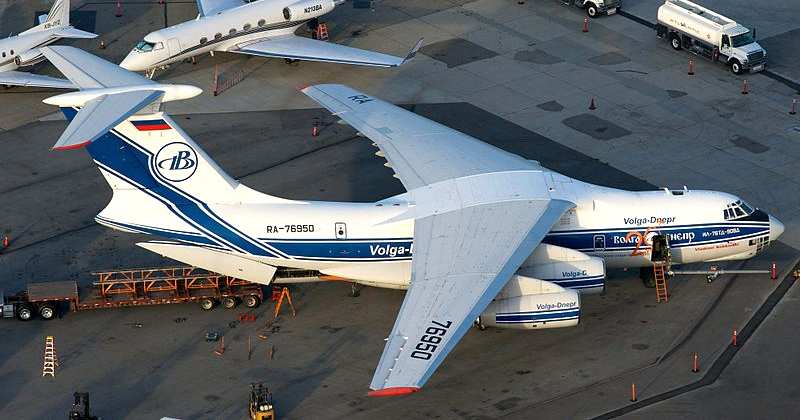
- Maximum Takeoff Weight: 210,000 kg (462,971 lb)
- Payload: 60,000 kg (132,277 lbs)
- Cargo Hold: 290 m3 (10,241 cu ft)
- Overall Length: 46.59 m (152 ft 10 in)
- Wingspan: 50.5 m (165 ft 8 in)
- Range: 4,200 km (2,610 mi)
- Cruise Speed: Mach 0.61 (759 km/h, 410 kn)
- Aircraft Type: Multiple
The Ilyushin IL-76TD is another large freighter that was developed in Russia in 1967, to replace the Antonov An-12. Surprisingly, the IL-76TD is still in operation and production today. It’s widely used for commercial transport and military operations, with more than 960 aircrafts built.
The Ilyushin IL-76-TD has a maximum takeoff weight of 210,000 kg (462,971 lbs). It has the smallest cargo hold of aircrafts in this list, coming in at only 290 m3 (10,241 cubic ft.), but it can hold a payload of 60,000 kg (132,277 lbs), and is commonly operated by 5 crew members.
As of 2021, Volga-Dnepr, who also operate the Antonov An-225m, have a total of 5 Ilyushin IL-76TD planes in their fleet. With a maximum range of 4,200 km (2,610 miles) they make great medium and long haul freighters for moving commercial cargo across continents.
15. Airbus Beluga
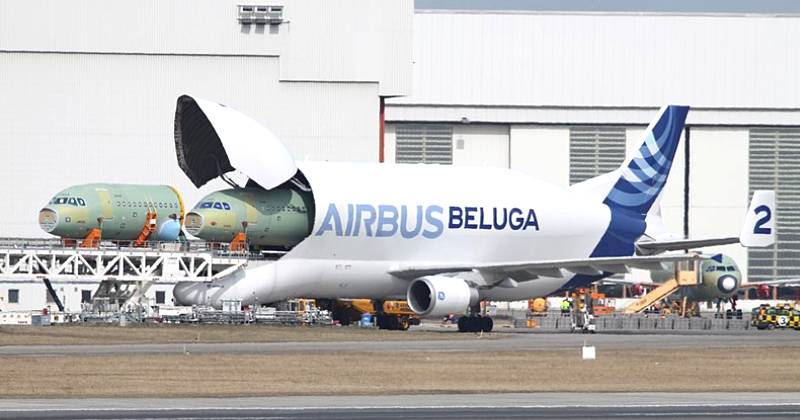
- Maximum Takeoff Weight: 155,000 kg (341,717 lbs)
- Payload: 47,000 kg (103,617 lbs)
- Cargo Hold: 1,500 m3 (53,000 cu ft)
- Overall Length: 56.15 m (184 ft 3 in)
- Wingspan: 44.84 m (147 ft 1 in)
- Range: 4,632 km (2,501 nmi)
- Cruise Speed: Mach 0.69 (737 km/h, 398 kn)
- Aircraft Type: Dedicated Airbus Freighter
The Beluga was developed by Airbus back in 1992 to 1999, with a total of 5 being built. The original name of this model was ‘Super Transporter’ and was also known by the name A300-600ST. It was the precursor to the larger Beluga XL and is powered by two General Electric CF6-80C2A8 engines.
The Airbus Beluga has many resemblances with the A300 and in fact shared the same landing gears, engines, wings, as well as the lower part of the fuselage. Similar to the bigger Beluga XL, this large cargo plane is used for transporting major Airbus components between their production sites in Europe.
It has an MTOW of 155,000 kg (341,717 lbs) and a large cargo hold of 1,500 cubic meters, which equates to about 53,000 cubic feet. The Airbus Beluga has a cruise speed of 737 km/h and a range of 4,632 km (2,501 nmi) at maximum payload.

Get Free Course Access
If you enjoyed the article, don’t miss out on our free supply chain courses that help you stay ahead in your industry.

Gerrit Poel
Co-Founder & Writer
at freightcourse
About the Author
Gerrit is a certified international supply chain management professional with 16 years of industry experience, having worked for one of the largest global freight forwarders.
As the co-founder of freightcourse, he’s committed to his passion for serving as a source of education and information on various supply chain topics.
Follow us